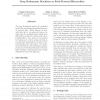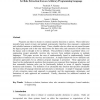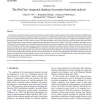130 search results - page 6 / 26 » Language networks: Their structure, function, and evolution |
38
Voted
JMLR
2012
11 years 10 months ago
2012
The deep Boltzmann machine is a powerful model that extracts the hierarchical structure of observed data. While inference is typically slow due to its undirected nature, we argue ...
GPEM
2006
13 years 7 months ago
2006
There are various representations for encoding graph structures, such as artificial neural networks (ANNs) and circuits, each with its own strengths and weaknesses. Here we analyz...
COMPSAC
2002
IEEE
14 years 15 days ago
2002
IEEE
Programs use rules to dictate or constrain specific decisions or actions. These rules have typically been tested, revised, and updated continuously; therefore, they represent a su...
CANDC
2004
ACM
13 years 7 months ago
2004
ACM
Increasingly, scientists have begun to tackle gene functions and other complex regulatory processes by studying organisms at the global scales for various levels of biological org...
COLING
2010
13 years 2 months ago
2010
Word co-occurrence networks are one of the most common linguistic networks studied in the past and they are known to exhibit several interesting topological characteristics. In th...



